| Pages:
1
2 |
teodor
National Hazard
   
Posts: 876
Registered: 28-6-2019
Location: Heerenveen
Member Is Offline
|
|
BaCrO4 and 3 different acids
It is my first post here.
I did some experiments with barium chromate. It is an interesting compound due to this reaction:
2BaCrO4 + 2H+ -> 2Ba2+ + Cr2O72- + H2O
And BaCr2O7 is quite soluble but BaCrO4 is not. But I doubt the former is possible to separate from an acidic solution - removing an acid by any means
converts it back to insoluble chromate. And what I tried to do today is to recover some Cr from BaCrO4 precipitate.
So, I put 3 different acid solutions in 3 different test tubes:
1) 1M oxalic acid;
2) 53% HNO3;
3) 6M HCl
and then I added a little BaCrO4 to each of them.
The 2nd and 3rd gave a nice colour of a dichromate ion and part of Ba2+ was dissolved. I think the amount of the dissolved substance should correspond
to a dissociation constant of a corresponding acid.
Then I thought I have to do something with acid anions and the only idea I had was to do some sort of oxidation. So, I dropped a little H2O2 to 2nd
and 3rd tubes.
The result was a bit surprising: HCl solutions turned green (with bubbles) and NHO3 turned blue (with bubbles, but not orange ones). I didn't smell
them, just put under my big Fan pointed to a window, so I had no precise idea, but in the second case I expected Cl2.
The first test tubes told a completely different story. Just after mixing BaCrO4 and H2C2O4 the solution was clear but after some time bubbles became
visible, and after heating in a water bath it was also bubbling (without H2O2, so, I think BaCrO4 acted as an oxidizer upon H2C2O4, so the gas
probably was CO2). The colour of solution was quite remarkable: I would describe it as "black", some kind of deep-blue-grey-purple tint.
I think it is amazing that 3 different acids gave 3 different colours with the same compound.
The photo is attached.
My question is: what are possible reactions and what compounds I've got? The 3rd colour is probably Cr(III), the second Cr(II) (but why, both HNO3 and
H2O2 are oxidizers?) and the 1nd is probably some complex ion, but I have no precise idea yet.
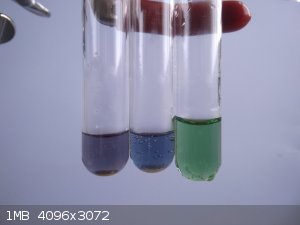
[Edited on 28-6-2019 by teodor]
[Edited on 28-6-2019 by teodor]
[Edited on 28-6-2019 by teodor]
|
|
|
Bedlasky
International Hazard
    
Posts: 1239
Registered: 15-4-2019
Location: Period 5, group 6
Member Is Offline
Mood: Volatile
|
|
Hi.
In first test tube dichromate reacts with oxalic acid to produce CO2 and chromium(III) oxalate complexes. In solution is cis and trans isomers of
[Cr(H2O)2(C2O4)2]-, trans isomer is purple and cis isomer is blue-gray. Maybe there is dark green [Cr(C2O4)3]3- too. Your purple colour is mix of
colours of these complexes. Here is text abou preparation of these complexes.
Dichromate in acidic solution oxidized hydrogen peroxide in to oxygen and dichromate is reduced in to chromium(III) (in basic media is this reaction
reverse - hydrogen peroxide oxidize chromium(III) in to chromate). After addition of peroxide in to the dichromate solution is formed very unstable
chromium(VI) oxide-peroxide CrO5 which is deep blue. This compound in aqueous solution quickly decompose in to chromium(III) and oxygen. But in
organic solvent like diethyl ether, ethyl acetate or amyl alcohol is much more stable.
Your solution in HNO3 is mix of complexes [Cr(H2O)6]3+ (which is dark purple) and [Cr(H2O)5(NO3)]2+ and [Cr(H2O)4(NO3)2]+ (which are green). Therfore
the solution is blue. If you warm this solution it becomes green due to transformation of hexaaqua complexes in to the nitrate complexes.
Your solution in HCl doesn't contain much of hexaaqua complexes. There is more chloride complexes [Cr(H2O)5Cl]2+ and [Cr(H2O)4Cl2]+ which are green.
|
|
|
teodor
National Hazard
   
Posts: 876
Registered: 28-6-2019
Location: Heerenveen
Member Is Offline
|
|
Thank you, Bedlasky for the both perfect and precise description.
Probably I will do the experiments with oxalato-chromates, the link is very interesting.
I know about chromium(VI) but according to my experience it always decomposes in several minutes in an aqueous solution. And in my experiment with
HNO3 it was very stable coloration. So, you are right, there is a mix of complexes in the 2nd tube. But after several hours and after warming
(slightly, in a water bath) it became more purple and not green. Probably I will do a few experiments with that to see if is there any difference
between K+ and Ba2+ behaviour.
Returning to my main point of interest with those experiments - to get both Cr and Ba ions in a water solution under normal pH from the really very
insoluble compound.
After I've got all BaCrO4 being dissolved in the 3rd tube (HCl + H2O2) I've added an excess of KOH and got a dirty-bluish-green precipitation and a
clear filtrate (see the picture).
It is evident that the filtrate contains Ba(OH)2 - I checked that both with K2CrO4 reagent and H2SO4 (got BaCrO4 and BaSO4 precipitation). And I
think I can get a really very pure Ba(OH)2 that way if I will use not KOH but NH4OH (which I can probably evaporate).
So the question is how to get the Cr part in the (separate) solution. I think it should not be too complex (dissolving the precipitate in an acid?)
but I'd like also to know more about chemistry of those [Cr(H2O)5Cl]2+ and [Cr(H2O)4Cl2]+ . Could you point me to some literature about them?
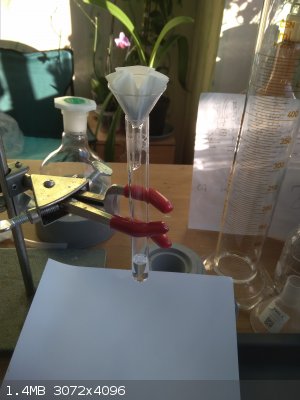
[Edited on 28-6-2019 by teodor]
|
|
|
teodor
National Hazard
   
Posts: 876
Registered: 28-6-2019
Location: Heerenveen
Member Is Offline
|
|
Today I had some evidence for my theory that BaCrO4 solubility is connected with an acid dissociation (ionization) constant. Apparently BaCrO4 is
absolutely insoluble in cold 12 M H3PO4 - I didn't get any coloration at all. Of course, it can interfere with solubility of barium phosphate (which
is insoluble) but in a case of H2SO4 - BaCrO4 is very soluble in it.
For the sake of completeness, I've dropped H2O2. So, this is how H3PO4 passed the BaCrO4 + H2O2 color test:
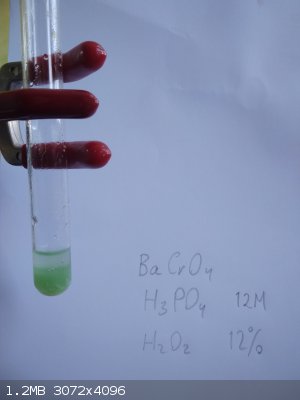
|
|
|
Bedlasky
International Hazard
    
Posts: 1239
Registered: 15-4-2019
Location: Period 5, group 6
Member Is Offline
Mood: Volatile
|
|
Warming of solution with nitric acid has really interesting result. I searched on web why is it purple and I found answer here on page 679.
There the order of coordinating tendencies of some common ligand with Cr(III):
oxalate>citrate>tartarate>glycolate>acetate>formate>sulfate>chloride>nitrate>perchlorate
Under this order is written: Thus if solution of [Cr(H2O)6]3+, for example, is required, the only anion present should be nitrate or perchlorate
since those of greater coordinating tendency may displace one or more of the coordinated water molecules.
So if you prepare Cr(III) solution by reduction of dichromate with hydrogen peroxide in nitric or perchloric acid you've get mix of [Cr(H2O)6]3+ and
Cr(III)-nitrate (or perchlorate) complexes. After warming of solution in hot water bath you've get solution mostly of [Cr(H2O)6]3+ which is purple,
because water molecules displaced nitrates (perchlorates). So sorry for my mistake - I never worked with chromium(III) nitrate, I came out of
experience with chromium(III) chloride and sulphate which undergo the reaction in the opposite direction  . This is very interesting experiment, I never seen this before, so thank you for this . This is very interesting experiment, I never seen this before, so thank you for this  . I'll definitely try it someday. . I'll definitely try it someday.
If you want to separate Ba2+ from Cr3+ use H2SO4 - BaSO4 will be precipitated and filtered off.
Good literature about displacing water molecules in [Cr(H2O)6]3+ with various common ligands is discribed here.
|
|
|
teodor
National Hazard
   
Posts: 876
Registered: 28-6-2019
Location: Heerenveen
Member Is Offline
|
|
Thank you again.
I briefly looked at the book, also I checked a preparation of different chromium complexes in Brauer's "Handbook of preparative inorganic chemistry".
Am I properly understand that orthophosphoric acid doesn't make any complexes with chromium (III), so the green precipitation in my 4th experiment
(with H3PO4) is either some hydrated form of Cr(OH)3 or anhydrous CrPO4?
Well, I know how to get rid of Ba if I don't want it, what is more interesting for me is how to get some defined and water-soluble chromium (III) or
(II) compound from those complexes mix (anions). Possible H3PO4 would help (if there are really no complexes exists) but wikipedia says it is
insoluble even in a hydrated form ... H2SO4? At least the procedure of synthesis of potassium chrome alum from K2Cr2O7 in "Inorganic preparation"
Fernellius is so simple - just add a starch into K2Cr2O7 and H2SO4 mix and you'll get that ... without any complex-es.
Upd: but really you already pointed me to the method of complex mix elimination, so probably I can get one defined complex from any of those mixes (so
I will know it's structure).
[Edited on 29-6-2019 by teodor]
|
|
|
Bedlasky
International Hazard
    
Posts: 1239
Registered: 15-4-2019
Location: Period 5, group 6
Member Is Offline
Mood: Volatile
|
|
How you get well defined chromium(III) soluble salt? Simpliest is get sodium or potassium chromium sulfate dodecahydrate (also known as potassium or
sodium chrome alum) from sodium (potassium) dichromate, sulfuric acid and suitable reducing agent in stechiometric ratio (personally I would add very
slightly more reducing agent, just for sure that reduction is complete), for example: H2O2, sodium (potassium) metabisulfite or sulfite, ethanol,
oxalic acid etc. Chrome alums have very low solubility so it would quickly crystalized. If you interested in making crystals, these compounds are very
good - they form nice dark purple (nearly black) octahedral crystals.
Another simple preparation of chromium(III) salt is chromium(III) chloride hexahydrate. Preparation is the same as for chrome alum, but instead
sulfuric acid you must use hydrochloric acid.
Both of these salts have low solubilities so you purify it throw fractional crystalization. Potassium chrome alum have solubility 3,9g/100ml of water
at 0°C, chromium chloride have solubility 5,85g/100ml of water at 25°C so at 0°C will be this solubility lower. Let evaporate solution in to volume
at which still sodium (potassium) sulfates or chlorides are soluble at 0°C and cool it down first at room temperature and after that put solution in
to fridge for 24 hours. On bottom you find your product. Residue chromium salt you can precipitate with sodium carbonate, wash it and dissolve in
H2SO4 or HCl (if you prepare chrome alum, don't forget add stechiometric amount of Na2SO4 or K2SO4) and evaporate to dryness.
Chrome alums are often written with simple formula ACr(SO4)2.12H2O, but better its strucutre describes formula A[Cr(H2O)6](SO4)2.6H2O - this is reason
why these salts are purple - they containt [Cr(H2O)6]3+ complex in its structure.
Similar situation is with chromium(III) chloride hexahydrate CrCl3.6H2O. Formula which better describes its structure is [Cr(H2O)4Cl2]Cl.2H2O.
Therefore is this salt green - it contain complex [Cr(H2O)4Cl2]+.
Don't be worry about these complexes  . They don't disruped Cr(III) chemistry.
Most of transition metal salts are complexes (for example ferric chloride hexahydrate is complex too). Simple salts like anhydrous CrCl3 are prepared
by oxidation of chromium by chlorine at high temperatures - nothing for home chemists. . They don't disruped Cr(III) chemistry.
Most of transition metal salts are complexes (for example ferric chloride hexahydrate is complex too). Simple salts like anhydrous CrCl3 are prepared
by oxidation of chromium by chlorine at high temperatures - nothing for home chemists.
For what purpose you want to get Cr(III) salt?
And yes, your precipitate is probably CrPO4. And why BaCrO4 didn't dissolve in H3PO4? Because H3PO4 is weaker acid than chromic acid.
[Edited on 29-6-2019 by Bedlasky]
|
|
|
DraconicAcid
International Hazard
    
Posts: 4333
Registered: 1-2-2013
Location: The tiniest college campus ever....
Member Is Offline
Mood: Semi-victorious.
|
|
Quote: Originally posted by Bedlasky  |
Similar situation is with chromium(III) chloride hexahydrate CrCl3.6H2O. Formula which better describes its structure is [Cr(H2O)4Cl2]Cl.2H2O.
Therefore is this salt green - it contain complex [Cr(H2O)4Cl2]+.
|
I seem to recall that it's possible to make several isomers of this- the monochloro monohydrate, the dichloro dihydrate (in both cis and trans), and
the trichloro trihydrate, depending on conditions.....
Please remember: "Filtrate" is not a verb.
Write up your lab reports the way your instructor wants them, not the way your ex-instructor wants them.
|
|
|
Bedlasky
International Hazard
    
Posts: 1239
Registered: 15-4-2019
Location: Period 5, group 6
Member Is Offline
Mood: Volatile
|
|
Yes, exist three isomers - dark green [Cr(H2O)4Cl2]Cl.2H2O; pale green [Cr(H2O)5Cl]Cl2.H2O and violet [Cr(H2O)6]Cl3. But I don't know how make pure
particular isomer.
|
|
|
teodor
National Hazard
   
Posts: 876
Registered: 28-6-2019
Location: Heerenveen
Member Is Offline
|
|
Well, I do some qualitative analysis and sometimes I need to do some tests with a composition of compounds I definitely know - to see how the method
should work in some known case. The purity of these compounds is important. For example, my home-made BaCl2 reagent (from a potter-grade BaCO2) have a
visible percent of Ca2+ even after 2 recristallizations, quite enough percent to make false results with some tests (also BaCl2 can be mix of hydrated
and anhydrous salt, so I never definitely know it's real molarity).
BaCrO4 compound is one of the way which I found to get pure Ba as well as Cr. And accidentally I have some quantity as a result of my previous
experiments.
So, I just do a mix of different salt with known percentage of different ions and then see how the method should work (before applying it to unknown
compound).
And I decided to add Cr as Cr(III) just because Cr(VI) is a strong oxidizer and can interfere on a stage of mixing different components together
(possible with some anions).
Quote: Originally posted by Bedlasky  |
And yes, your precipitate is probably CrPO4. And why BaCrO4 didn't dissolve in H3PO4? Because H3PO4 is weaker acid than chromic acid.
[Edited on 29-6-2019 by Bedlasky] |
Oh, so simple.
But BaCrO4 doesn't react with H2O2 without an acid. And H3PO4 is quite good as an acid to keep very active reduction/oxidation reaction between them,
just as good as any other acid I tried. That's why I start to thing about an ionization. Never mind, I have to better study the theory.
About alums - yes, Chrome-ammonium alum was one of my first compound I bought in my childhood for the purpose of chemistry (I think in some photo
shop). And now I am making a "reproduction" of a Gilbert's chemistry set - http://science-notebook.com/gilb-chem01.html (for children of my friend), so definitely I will create some alums for it (it should have 4 alums in
a set).
[Edited on 29-6-2019 by teodor]
[Edited on 29-6-2019 by teodor]
|
|
|
teodor
National Hazard
   
Posts: 876
Registered: 28-6-2019
Location: Heerenveen
Member Is Offline
|
|
Upon standing the green compound dissolved. Any idea what is it or how I can do an analysis of the dissolved green compound?
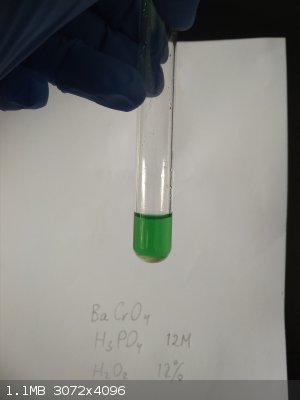
|
|
|
teodor
National Hazard
   
Posts: 876
Registered: 28-6-2019
Location: Heerenveen
Member Is Offline
|
|
Quote: Originally posted by Bedlasky  | | Yes, exist three isomers - dark green [Cr(H2O)4Cl2]Cl.2H2O; pale green [Cr(H2O)5Cl]Cl2.H2O and violet [Cr(H2O)6]Cl3. But I don't know how make pure
particular isomer. |
I made evaporation of the mixed compound.
The procedure:
I. BaCrO4 + HCl + H2O2
II. Excess of KOH and filtration, 3 washes of the Cr containing precipitation with hot water
III. Dissolving the precipitate in HCl and evaporation of the filtrate.
The upper part of dish contains some pink compound (HCl acid was fully evaporated here) and the bottom part is green (some HCl was left there but with
cooling it disappeared). My photo skills are not perfect and the pink part is barely visible, but it exists in the same order of magnitude as the
green one.
So, probably with evaporation & ignition I've got the last complex.
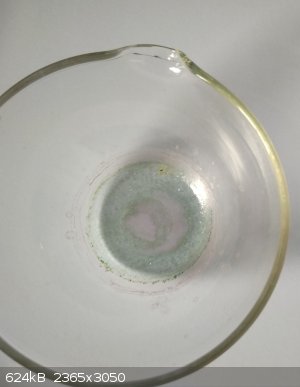
[Edited on 30-6-2019 by teodor]
[Edited on 30-6-2019 by teodor]
[Edited on 30-6-2019 by teodor]
[Edited on 30-6-2019 by teodor]
|
|
|
Bedlasky
International Hazard
    
Posts: 1239
Registered: 15-4-2019
Location: Period 5, group 6
Member Is Offline
Mood: Volatile
|
|
Maybe it slowly form soluble hydrogenphosphate complexes like ferric ions. But I am not sure about that.
Only text I found about Cr-phosphate complexes is here.
Edit: About your crystals separation - if you add excess of KOH in to chromium-barium solution you nothing separate - barium hydroxide is soluble in
water and chromium hydroxide is soluble in hydroxide solutions.
[Edited on 30-6-2019 by Bedlasky]
[Edited on 30-6-2019 by Bedlasky]
|
|
|
teodor
National Hazard
   
Posts: 876
Registered: 28-6-2019
Location: Heerenveen
Member Is Offline
|
|
Quote: Originally posted by Bedlasky  |
Edit: About your crystals separation - if you add excess of KOH in to chromium-barium solution you nothing separate - barium hydroxide is soluble in
water and chromium hydroxide is soluble in hydroxide solutions.
[Edited on 30-6-2019 by Bedlasky] |
It's strange because I've got the clear filtrate, see my picture. The presence even tiny amount of chromium compound is always visible. The
builsh-green precipitate was dissolved only with HCl addition.
UPD: upon stending the "pink" part in the evaporati dish turns green too. Both parts now consists of some amorphous green mass with white cubic
crystals "glued" in it (visible under a microscope).
[Edited on 30-6-2019 by teodor]
|
|
|
Bedlasky
International Hazard
    
Posts: 1239
Registered: 15-4-2019
Location: Period 5, group 6
Member Is Offline
Mood: Volatile
|
|
Quote: Originally posted by teodor  | | It's strange because I've got the clear filtrate, see my picture. The presence even tiny amount of chromium compound is always visible. The
builsh-green precipitate was dissolved only with HCl addition. |
In that case hydroxide isn't in excess. For these type of compounds which have amphoteric hydroxides for example chromium(III), aluminium or zinc
salts I personaly prefer precipitated them with carbonate. Excess of carbonate doesn't dissolve precipitate. But in your case you must first
precipitate barium with sulfate if you want to use this method.
|
|
|
teodor
National Hazard
   
Posts: 876
Registered: 28-6-2019
Location: Heerenveen
Member Is Offline
|
|
Ah, ok. I wrote "excess" because I've added it till pH became alkaline, not neutral.
Adding H2SO4 to Ba solution usually is the worst thing I can imagine in a nightmare. Especially if the purpose is to purify barium 
Well, it seams that a chromium acid cleaning solution has no problem with dissolving a great amount of BaSO4 per ml of solution in cold, but getting
soluble barium ions out of this system probably is not an easiest task.
[Edited on 30-6-2019 by teodor]
[Edited on 30-6-2019 by teodor]
[Edited on 30-6-2019 by teodor]
|
|
|
Bedlasky
International Hazard
    
Posts: 1239
Registered: 15-4-2019
Location: Period 5, group 6
Member Is Offline
Mood: Volatile
|
|
Why?
Quote: Originally posted by teodor  | | Well, it seams that a chromium acid cleaning solution has no problem with dissolving a great amount of BaSO4 per ml of solution in cold
|
Chromic acid doesn't dissolve BaSO4.
|
|
|
teodor
National Hazard
   
Posts: 876
Registered: 28-6-2019
Location: Heerenveen
Member Is Offline
|
|
I think it does. In particular the acid prepared by the method from Vogel's "organic chemistry" (dissolving K2Cr2O7 in concentrated H2SO4 at 100
degrees C). Sorry, I will be able to make some quantitative experiment to proof that only after finishing with my purification process to be sure that
I have a high grade BaSO4.
And I think this correlates with the fact that BaCrO4 also dissolves in H2SO4 ... well, I can be wrong with that, so I will write something on this
topic after finishing.
I just found something interesting upon treating Cr + H3PO4 solution with KOH, next few days possible will try to figure out what happend.
[Edited on 30-6-2019 by teodor]
[Edited on 30-6-2019 by teodor]
[Edited on 30-6-2019 by teodor]
[Edited on 30-6-2019 by teodor]
[Edited on 30-6-2019 by teodor]
[Edited on 30-6-2019 by teodor]
|
|
|
teodor
National Hazard
   
Posts: 876
Registered: 28-6-2019
Location: Heerenveen
Member Is Offline
|
|
I think you didn't get the main purpose of these experiments. May be because I've posted a lot of small details.
BaCrO4 is a very special compound.
1. It insoluble in water and other alkali-earth (and most of other metals) are soluble. Pouring water into BaCrO4 easily separates CaCrO4. If the
water becomes orange or yellow you know that you still have other cations.
2. It soluble in many acids.
3. It has a very special colour different from colour of other chromates especially different from colour of CaCrO4, which I want to separate. It is
not so difficult to check the purity of Ba cation just looking at the colour. The last point is questionable but it helps, at least for me.
(There is also process of Ba/Ca separation based on properties of BaC2O4, but it is completely different story).
So, I try to use BaCrO4 as a source of analytical-grade (for qualitative analysis purposes at least) Ba and Cr.
Pouring H2SO4 (also analytical grade of course) into Ba2+ solution will make analytical grade BaSO4 which is only thing I can do with is it to pour it
down the drain.
[Edited on 1-7-2019 by teodor]
[Edited on 1-7-2019 by teodor]
|
|
|
Bedlasky
International Hazard
    
Posts: 1239
Registered: 15-4-2019
Location: Period 5, group 6
Member Is Offline
Mood: Volatile
|
|
I thought that you want separate only Cr(III) as a pure solid, sorry  . .
So the appropriate method is probably the one you used first - adding hydroxide solution in small portion until pH is slightly basic. Filter Cr(OH)3,
wash it and dissolve in some acid. Than precipitate Ba as BaCO3, filter it, wash it and dissolve in acid (be careful about aerosol during dissolving
of BaCO3, don't breath it and do it outside or in fumehood).
|
|
|
teodor
National Hazard
   
Posts: 876
Registered: 28-6-2019
Location: Heerenveen
Member Is Offline
|
|
Yes, I always try to be careful. But usually the danger is where you don't expect it.
But actually, may be we overestimate the danger of barium salts? To get sick of it the consumption should be hundreds of mgs or so - I hardly imagine
the aerosol could contain such amount. And it is not cumulative. Anyway, it is better to be on a safe side, and it is what I actually do.
There are some conditions when this procedure (with KOH) doesn't work. H2O2 still present in the solution and with addition of KOH the process turns
from reduction to oxidation (you wrote it in your first post). And in one case I've got my Cr(VI) back. But some changes in starting conditions
prevents it. Now I try to figure out how it works. Thank you for your comments.
[Edited on 1-7-2019 by teodor]
|
|
|
Bedlasky
International Hazard
    
Posts: 1239
Registered: 15-4-2019
Location: Period 5, group 6
Member Is Offline
Mood: Volatile
|
|
After reduction of chromate boil solution for some time --> H2O2 will decompose.
[Edited on 1-7-2019 by Bedlasky]
|
|
|
nezza
Hazard to Others
  
Posts: 324
Registered: 17-4-2011
Location: UK
Member Is Offline
Mood: phosphorescent
|
|
I suspect the green/blue colours you are getting are due to reduction of the chromate ion by the acids you have added. Barium chromate is pale yellow
and soluble in strong non-oxidising or reducing acids such as perchloric. Chromate will oxidise HCl and Oxalate and Nitrate can act as an oxidiser or
reducing agent. I have attached a picture of some neutral chromates.
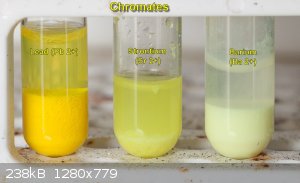
If you're not part of the solution, you're part of the precipitate.
|
|
|
Bedlasky
International Hazard
    
Posts: 1239
Registered: 15-4-2019
Location: Period 5, group 6
Member Is Offline
Mood: Volatile
|
|
Dichromate oxidize dilute HCl slowly. Teodor added H2O2 in to the solutions of BaCrO4 with HNO3 and HCl - H2O2 was act as reducing agent. Nitrate
isn't able to act as reducing agent - nitrogen in nitrate have maximum oxidation state.
[Edited on 8-7-2019 by Bedlasky]
|
|
|
nezza
Hazard to Others
  
Posts: 324
Registered: 17-4-2011
Location: UK
Member Is Offline
Mood: phosphorescent
|
|
Adding peroxide to acidic solutions/suspensions of chromate gives peroxychromic acid (CrO5). This is dark blue but rapidly decomposes to Cr(III) in
aqueous solution.
If you're not part of the solution, you're part of the precipitate.
|
|
|
| Pages:
1
2 |